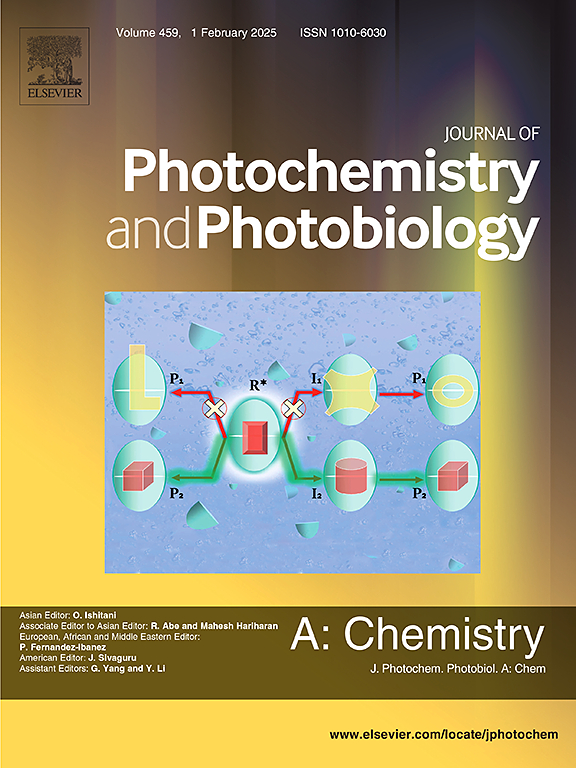Dynamic behavior of the fluorescence features of Eosin Y in PVA-Borax hydrogel
IF 4.1
3区 化学
Q2 CHEMISTRY, PHYSICAL
Journal of Photochemistry and Photobiology A-chemistry
Pub Date : 2025-02-22
DOI:10.1016/j.jphotochem.2025.116358
引用次数: 0
Abstract
In most biophotonics applications of dye-gel blends, the gel is illuminated by a light source (usually a laser or LED) for a considerable period of time. Therefore, it is crucial to examine the temporal behavior of the corresponding luminescence features. In the present report, a photosensitive hydrogel was synthesized using Eosin Yellow (EY) as the dye, Polyvinyl Alcohol as the polymer and Borax as the cross-linking agent (EY-PVA-Borax hydrogel). Dynamic behavior of the corresponding fluorescence emission due to excitation of by a diode laser at λ = 445 nm (which is the isosbestic point of the EY absorption spectrum during the photodegradation process) were studied parametrically and evaluated using difference spectra analysis (DSA). In general, the wavelength at the fluorescence peak underwent hypsochromic shift with irradiation time, while the intensity increased in the first 9.0 s and then decreased gradually. Hydrogen bonding between the hydroxyl group of PVA and the carboxyl group of EY, aggregation of the EY molecules and debromination of the EY monomers under light irradiation were considered to explain the dynamic behavior of the fluorescence emission from the gel. Considering the use of hydrogels as photo-convertors, the influence of gel layer thickness on the fluorescence spectrum was examined. The results obtained are of particular importance for the design of fluorescence-based biosensors and also in the field of fluorescence biomodulation.

求助全文
约1分钟内获得全文
求助全文
来源期刊
CiteScore
7.90
自引率
7.00%
发文量
580
审稿时长
48 days
期刊介绍:
JPPA publishes the results of fundamental studies on all aspects of chemical phenomena induced by interactions between light and molecules/matter of all kinds.
All systems capable of being described at the molecular or integrated multimolecular level are appropriate for the journal. This includes all molecular chemical species as well as biomolecular, supramolecular, polymer and other macromolecular systems, as well as solid state photochemistry. In addition, the journal publishes studies of semiconductor and other photoactive organic and inorganic materials, photocatalysis (organic, inorganic, supramolecular and superconductor).
The scope includes condensed and gas phase photochemistry, as well as synchrotron radiation chemistry. A broad range of processes and techniques in photochemistry are covered such as light induced energy, electron and proton transfer; nonlinear photochemical behavior; mechanistic investigation of photochemical reactions and identification of the products of photochemical reactions; quantum yield determinations and measurements of rate constants for primary and secondary photochemical processes; steady-state and time-resolved emission, ultrafast spectroscopic methods, single molecule spectroscopy, time resolved X-ray diffraction, luminescence microscopy, and scattering spectroscopy applied to photochemistry. Papers in emerging and applied areas such as luminescent sensors, electroluminescence, solar energy conversion, atmospheric photochemistry, environmental remediation, and related photocatalytic chemistry are also welcome.

 求助内容:
求助内容: 应助结果提醒方式:
应助结果提醒方式:


